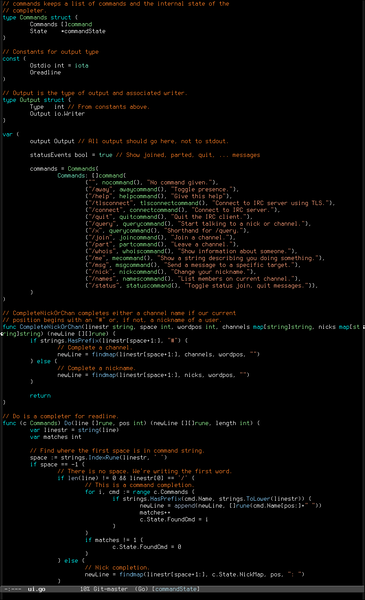
Every geek likes to brag about her setup. This is my attempt. The text is likely to be out of date, slightly incomplete and most likely a bit silly, but perhaps some fellow geeks will still find it interesting.
The focus here is on equipment I have owned or have used so much outside of work that they were my main equipment. Equipment at work is usually not mentioned unless it was especially interesting.
Some of the photos below were taken by me and some come from other web sites. I have tried to follow the fair use policies of these sites.
TL;DR:
I spend most of my time in front of a computer staring at something like this:

This is GNU Emacs, a text editing environment based on a version of the Lisp programming language.
I typically have between three to six Emacs frames on two screens (back when I believed in Zaphod mode) open at the same time. Some of them are devoted to programs running inside Emacs, some change depending on what I'm working on. All those frames belong to at least two Emacs processes: One local and at least one running on a shell box in a colocation facility.
Emacs is, as some people say in a ha ha only serious-way, really an operating system cleverly disguised as a text editor. Imagine the bliss if Emacs, but with a proper, incremental garbage collector, real processes and better scheduling, could run on top of the bare metal. The Lisp Machine back among the living!
An acquaintance, Taylor, once said that "Emacs is an artificial intelligence that has been parasitically masquerading as a text editor". I thought it was funny. Then I thought about it again...
I got stuck with Emacs in 1991 and seem to get more stuck as time passes. I've tried to escape a few times, for instance to Oberon, Sam, Wily, Acme or Jed, but haven't really succeeded yet.
I use many Emacs Lisp programs: For mail, address book, chat, organising my notes and playing music and movies:
Gnus is an NNTP and mail client I used for 15+ years as my main mail client before straying into Wanderlust and mu4e for a while and then back to Gnus.
Of course, I used to use Gnus for real Usenet News as well, but Usenet is mostly dead these days, except for a few stalwarts like alt.sys.pdp10 and alt.folklore.computers which I read until rather recently.
Lars Ingebrigtsen's wonderful Gmane server also uses NNTP to deliver public mailing lists and blogs to us old Usenet junkies. It's much more convenient to read them like if they were Usenet. Connect with NNTP to news.gmane.io.
Since 2019 I use Gnus only for NNTP access and use Notmuch Mail's Emacs frontend for mail.
LysKOM is a client to connect to an in-house conference system at the Lysator Academic Computer Society at Linköping University.
I use the rather minimalist builtin rcirc IRC client, extended
with a few elisp functions. Some days this is where most of my
social life is. Yeah, I know... I know...
I use Org Mode heavily for all my planning and to take down notes. I usually create about 3 megabytes of notes in plain text a year, evenly divided between work and free time.
My music needs are satisfied by the Emacs Multimedia System (EMMS), an Emacs frontend to some command-line media players and metadata editors. It also controls an mpd running on a media computer hooked up to the stereo in the living room.
mastodon.el is a social media client for the Mastodon API. You can find me as @mc@hackers.town. I'm no longer using Twitter but then I did I used twittering-mode.
In 1991 I also discovered screen which I thought amazing. Screen is a terminal multiplexer, something like a window system for a character terminal. It makes it very easy to run lots of simultaneous programs using an ordinary character terminal or a terminal emulator. These days I use tmux instead but since 1991 I've been using either screen or tmux almost every day.
tmux pairs well with the iTerm2 terminal
emulator on macOS. Try tmux -CC if you're using iTerm2! It feels
almost like Howard Chu's rmgr in the early 90's... Too bad this
isn't supported under any other OS so far.
Since 1996 or so I've been using zsh as my shell. During some years in the 1990s I used Byron Rakitzis re-implementation of Tom Duff's rc and the real rc on my Plan 9 workstation at work.
Since I first got a personal laptop/Thinkpad the operating system on it has changed between Debian, FreeBSD/HardenedBSD, and OpenBSD several times. Yes, of course I also ran Plan 9 for a while.
I use mostly Firefox to browse the web (Wayland support!). Important plugins are at least uBlock Origin, NoScript, and Vimium.
Most of my software development is done in Go, C with LLVM/clang and/or GCC, Python or Perl. I usually use Git, with the built-in Emacs VC or Magit, for version control.
These days I mostly use Arch, Debian and FreeBSD.
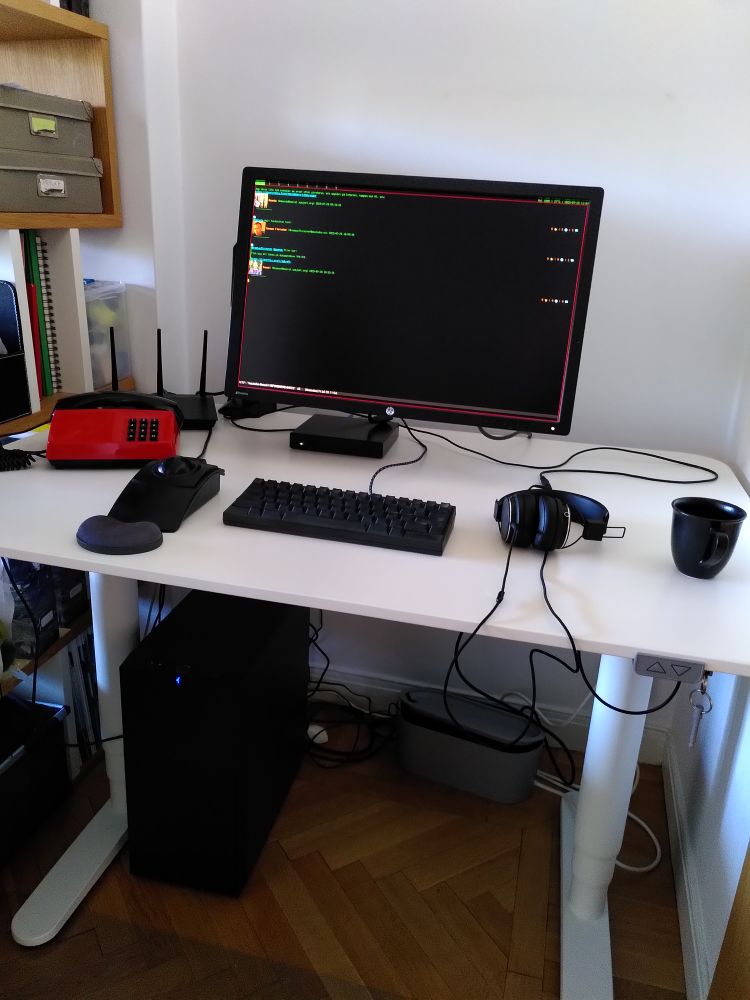
From november 2021 my main workstation at home is based on an Intel Core i9-9900K @ 3.60GHz with 32 GiB RAM in a Fractal case with 1 TiB SSD running Arch. I bought it from work when I quit that job. It's very silent, thankfully.
The workstation is under a small sit/stand IKEA desk (Bekant) in the living room and is connected to a HP Z24i 24" 1920x1200 IPS monitor mounted on a gas arm, a black Happy Hacking Keyboard Professional 2, and a CST L-Trac X trackball.
I used to have a 27" monitor here but it got too distracting. The big monitor is now our not-TV and used for watching movies instead.
Other interesting things in the photo is the working red/black Diavox phone connected to a Cisco prototype unit SIP ATA box. Reach out if you want to call me! There's also an Asus wifi access point and a PC-Engines APU2 I use as a router/firewall combo running FreeBSD, one of my favourite computers at home. So cute!
My main laptop is a Lenovo Thinkpad x230 with an i5-3320M @ 2.6 GHz, refurbished with 16 GiB RAM (max according to spec is 8!), and a 240 GiB SSD instead of a spinner running Debian Sid. Before I had the above workstation it was often connected to an HP Z-27 27" 2560x1440 IPS panel, the HHKB and the CST like this:
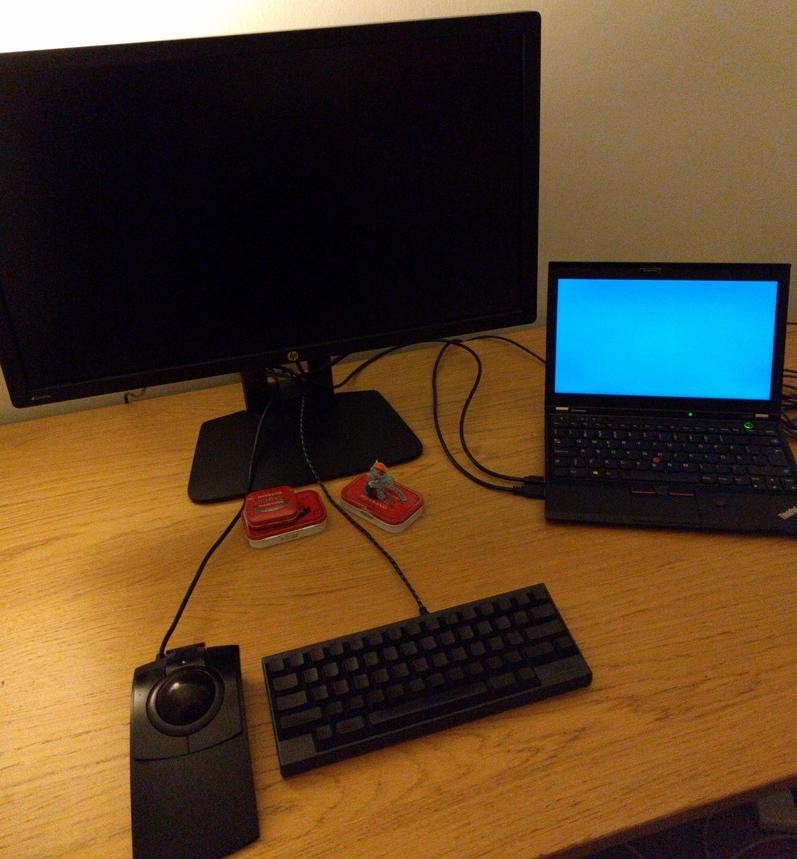
until the pandemic when my wife urgently needed an external monitor and nabbed my 27" screen.
I bought two used Lenovo Thinkpad x230 (made in 2012) in December 2016. One to use as my main computer and the other one to experiment on, or perhaps use as a travel computer. Both have been upgraded to 16 GiB RAM, use SSDs instead of spinners and got new batteries (several times, now).
The reason I bought x230s was that they have excellent hardware support in the free operating systems. The Coreboot alternative firmware also works on them.
I work from home. This is what my work desk looks like:
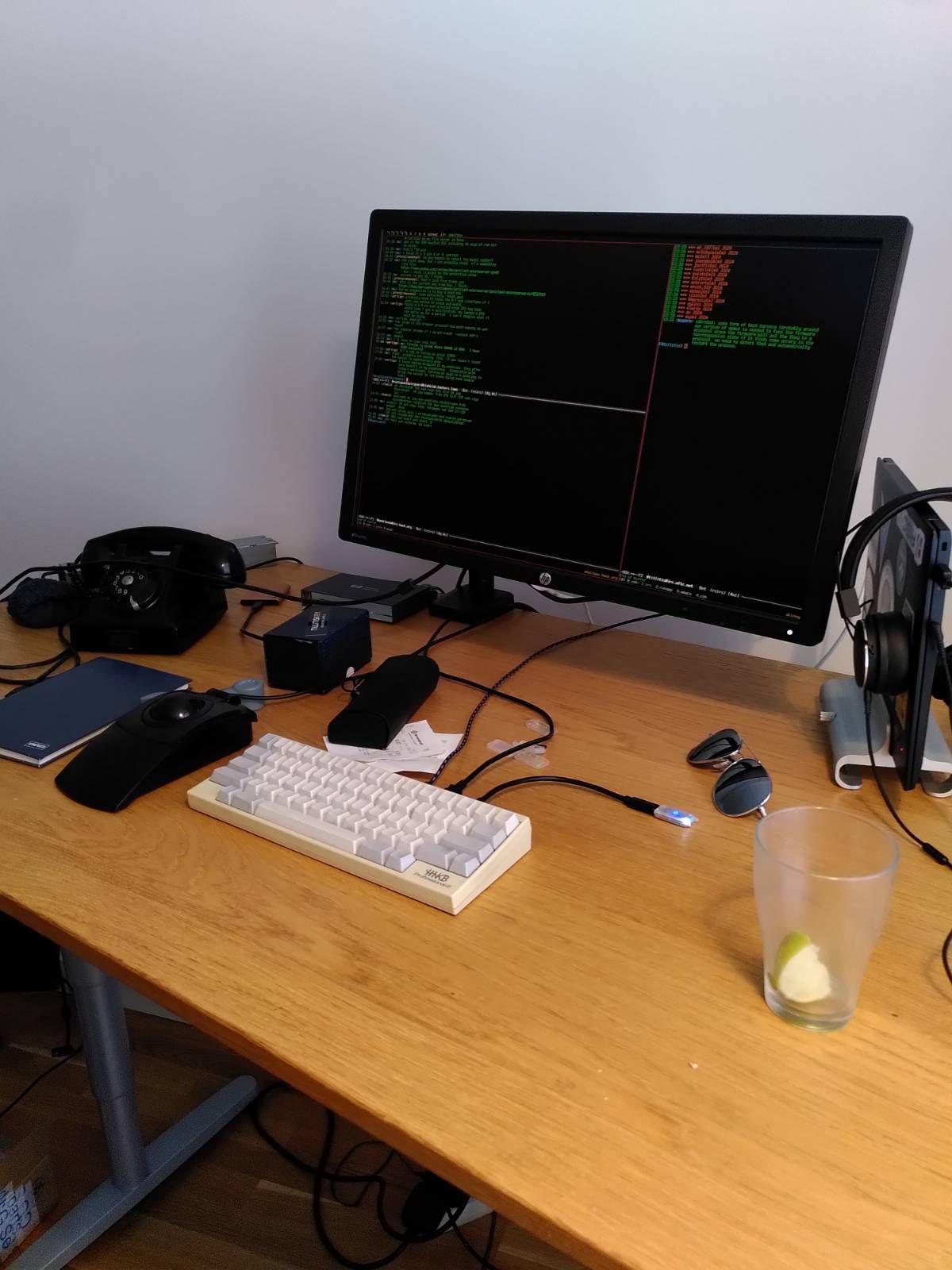
From left to right: A working m/50 bakelite rotary phone, an Ethernet switch, a box with a Tillitis TKey, my notebook, a CST L-Trac trackball, a HHKB Pro 2 keyboard, an HP 24i 24" 1920x1200 IPS monitor I bought used mounted on a gas arm, and a Thinkpad X1 gen 9 in a stand with a couple of Urban Ears Plattan headphones hanging on top of it.
You don't see my wonderful Håg Capisco chair. The desk is a motorised IKEA Galant.
Before the 24" I tried working with 27" and even 34" screens. I also tried several screens at once. Didn't work. I'm distracted enough as it is. I like to keep things simple and unadorned even though I admit I'm very good at creating chaos of my work area.

A Mac Mini (2014) in our living room running a Linux distro with an ordinary computer screen, a Dell U2719D 27" 2560x1440 IPS. It's hooked directly with RCA to a Sony receiver which drives the speakers. This is mostly used for listening to music and watching movies. Not actually much of a home theatre, I know, but I'm not very picky, and this setup gives me a lot of control.
Currently the media computer is used with a wired Trackpoint keyboard but it will probably be a lot better when I get a wireless Trackpoint so I don't have to get up from the sofa!
The music player used to be a wonderful SqueezeBox, but unfortunately it's broken. It was replaced by a Raspberry Pi B+ running Raspian with the Music Player Daemon for many years but was replaced with the Mini in 2023.
A no-name minimal DVD/BD player (under the Mac) is also connected to the same screen and receiver.
The media computer mounts media over NFS over IPv6 from the home file server.
The Mini has a lot better audio output than the Raspi it replaced but I still miss the SqueezeBox.
During the Covid-19 pandemic I was sort of quarantined in my cottage. I made a fairly decent, but improvised home office in the cottage, here with my work computer at the time, a Thinkpad x270, and an old HP 24" 1920x1200 IPS panel (no LED backlight!).
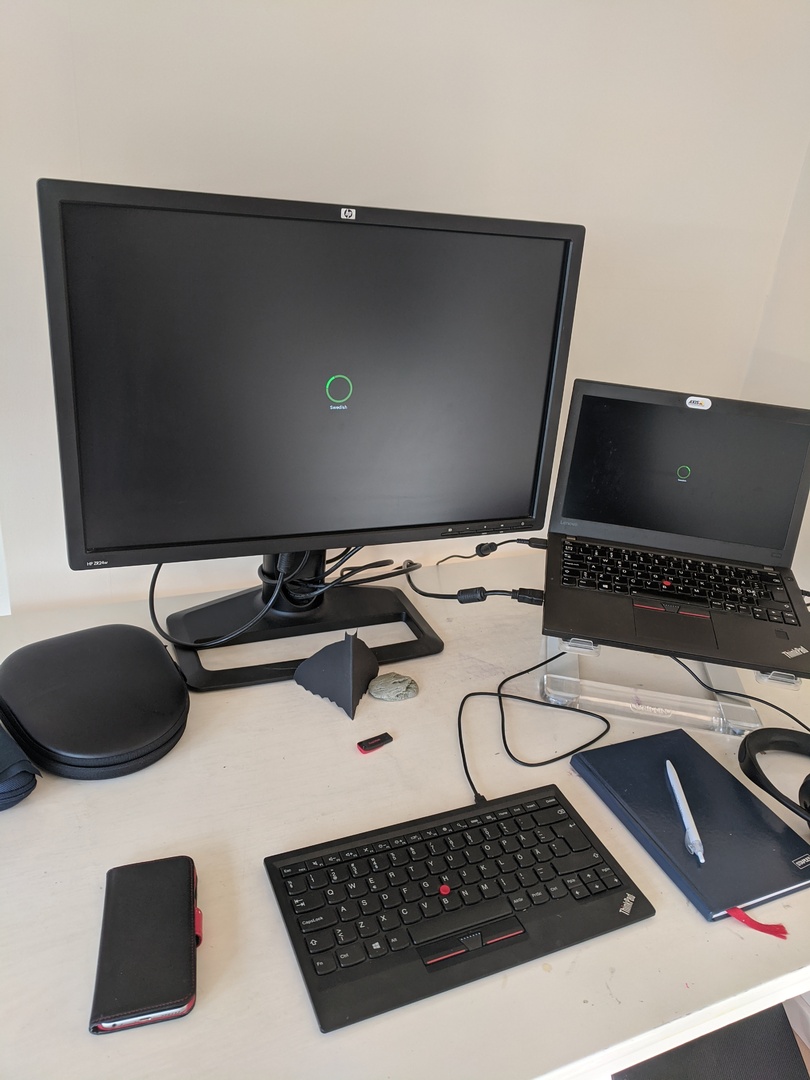
I still use the old 24" with my private laptop and work computers if I'm working from the cottage.
For many years I refused to have a mobile phone. Of course, I didn't have a land line either. Speaking on the phone is scary. Then I refused to have a smartphone, insisting on using hand-me-down feature phones that I usually turned off and removed the battery from at the first opportunity.
These days I have resigned to have an electronic snitch in my pocket. I ran CopperheadOS on a Nexus 5X for a while but then Copperhead the company sort of imploded. My current phone is a Fairphone 4. Their goal with fair trade and sustainaible phone which is easy to repair resonates with me.
I use CalyxOS, an alternative degoogled version of Android. I don't run the Google Play Services, not even with microG. I get my apps from F-Droid. I use the phone mostly for reading blogs, taking photos, music, podcasts, and messaging over Signal. Actual phone calls are kept to a minimum but even they are actually better now with this phone compared to older ones.
While trying to cope with my slight phone phobia I've been interested in VoIP for a while, so I have ATA boxen with an analog phones permanently on the EPVPN and yet another phone on another ATA actually bridged to the PSTN. Contact med for my EPVPN extension if you want to talk.
Both my desks are motorised IKEA Galant which can easily be adapted for sitting or standing position.
I usually switch between sitting and standing a few times during the day.
I have two Happy Hacking Keyboard Professional 2 keyboards, one white and one black. Both have blank keytops. I also have a couple original HHKBs but they are seldom used nowadays.
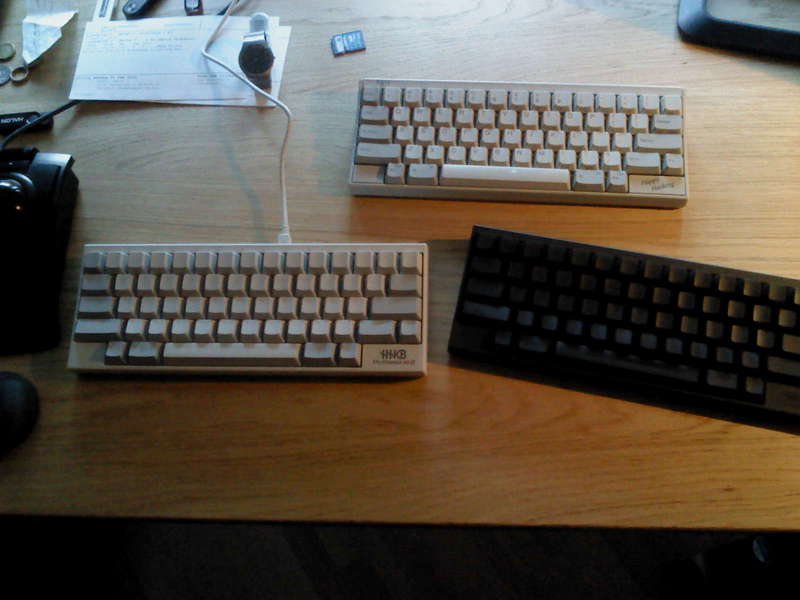
The original HHKB was an ordinary rubber dome keyboard (top in photo above) but had a very nice layout and could optionally connect to the Sun workstation type 4 interface, Apple Macintosh ADB and to PCs using PS/2.
The keyboard was designed in the early 1990s by Dr. Eiiti Wada but not released as a staple product until 1996. Probably a few was available much earlier than that but made to order from PFU.
The key layout comes from the much loved Sun Type 3 keyboard but without all the extra function keys. No one I know has ever used the Sun function keys for anything, except for the L1-A combination, of course, so good riddance. As a comparison, here's an original Type 3:

(Image from Online Sun Information ArcHive.)
Imagine the L (left), F (top) and R (right) functions keys gone and you have the HHKB layout.
I used the Type 3 a lot on Lysator's workstations and on my Sun 3/60 (see below) and it was dearly missed, especially when I had to use PCs.
I've been using a customized Swedish keyboard layout in for quite some time. Its first level looks like this:
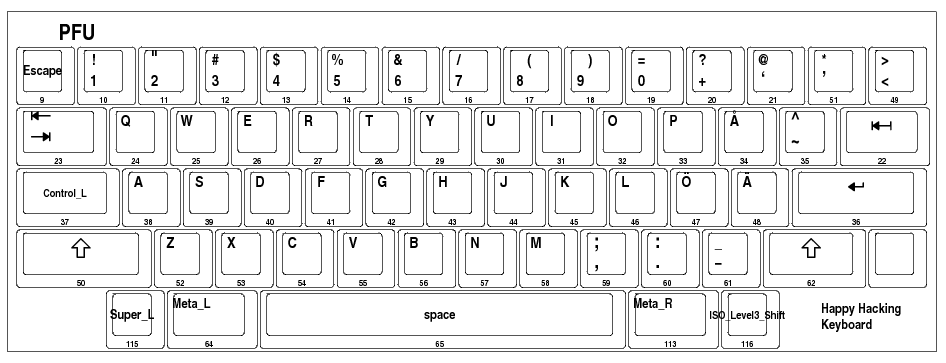
With AltGr (the key labeled "ISO_Level3_Shift" above) the åäö keys generates braces and bar. With AltGr + shift you get brackets and backslash. It's much easier to reach them there compared to the default position on a current Swedish keyboard. There is a bit of history behind this choice as well.
Back when 7 bit ASCII terminals were common the Swedish version of ASCII (ISO/IEC 646-SE and -SE-C) placed the Swedish characters åäö on braces, brackets, bar and backslash. A programmer back then who was lucky enough to have a terminal that could actually show the braces instead of Swedish characters typed on the key labeled "Å" on her keyboard to get a "}". Now I just have to remember to press AltGr as well.
I use a CST L-Trac X trackball as a pointing device when at my desk.
My main server is a Supermicro Superworkstation with an Intel Xeon W3680 (six 3.33 GHz cores * 2 with HT) with 24 gigs of three-way ECC RAM and ZFS on two mirrored 2 TiB disks in an 8 piece hot-swap drive bay. It lives in a co-location facility.
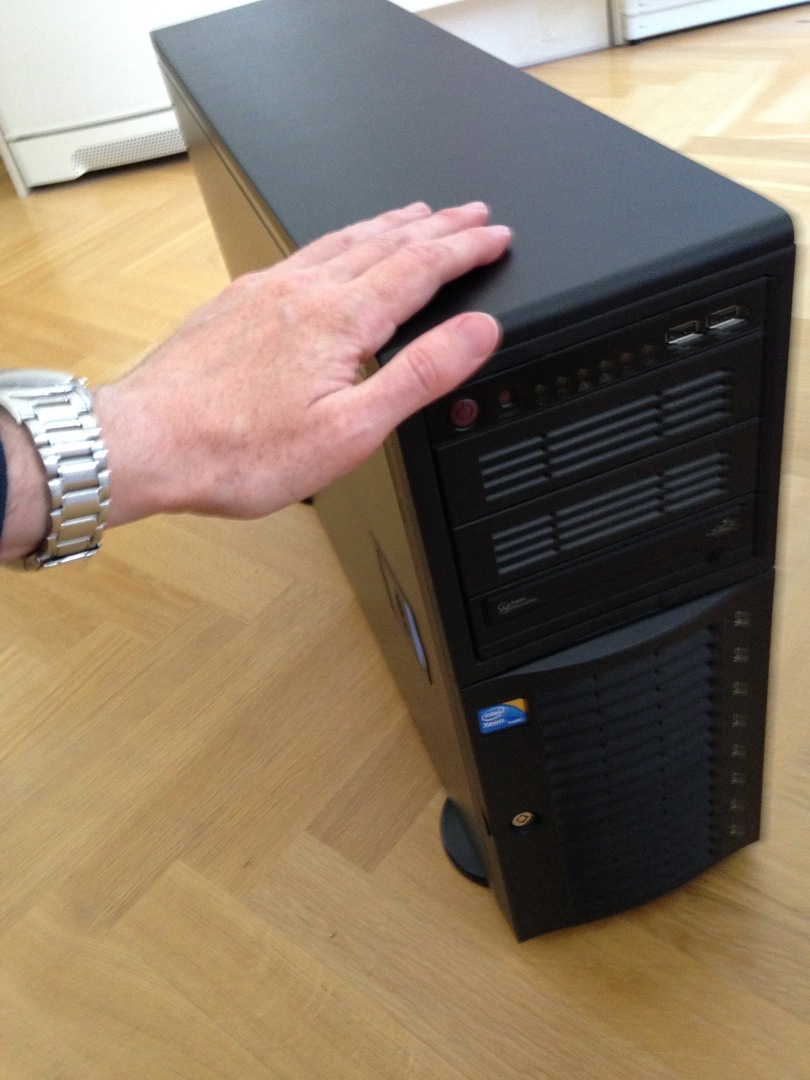
I call it totoro because it's huge and really screams, albeit not blue and cuddly. I might just paint it blue! It runs FreeBSD, mostly because of jails and ZFS.
Totoro is very fast. To give you some idea just how fast it is I can mention that I used to dream of having access to a small VAX with BSD while at secondary school. I imagined we would be something like 30–50 simultaneous users on the VAX. A single core on my new machine is something like 300,000 times faster!
The home file server is a HPE MicroServer Gen 8 with 16 GiB ECC RAM I bought used and 5 TiB of spinners.
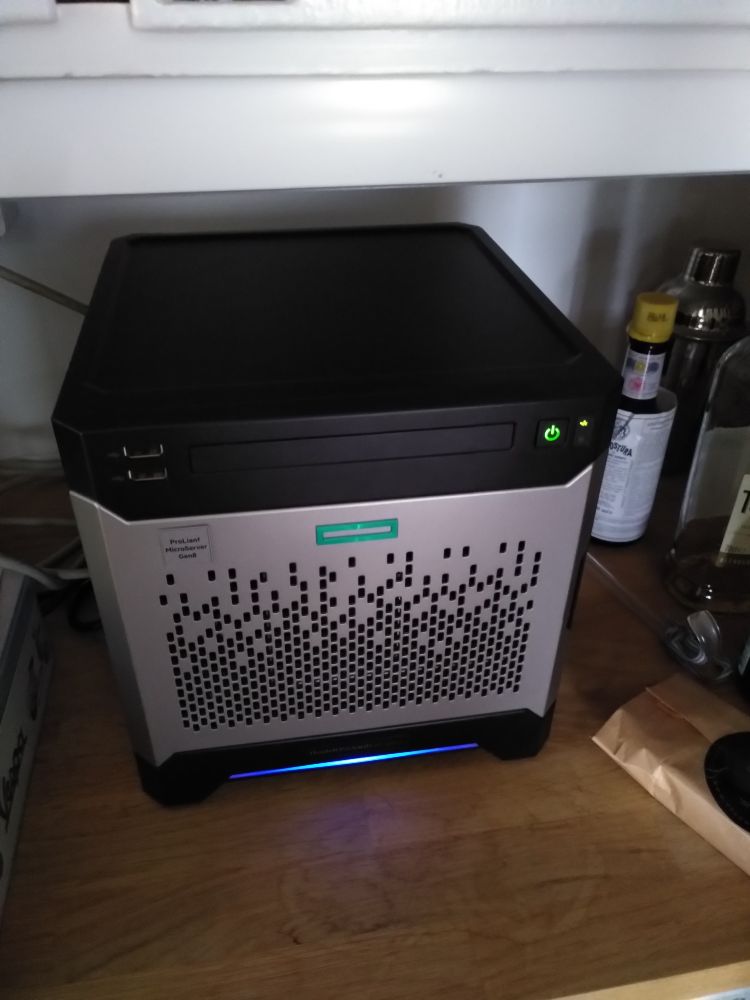
Of course, other family members also have computers. They can tell you all about it, if they choose, on their own web pages.
I have a couple of older laptops in a cupboard that I don't know what I'll do with.
I used to have lots and lots of computer junk at home, but I have tried to give most of it away to better homes. I still keep some stuff, such as an original 1978 vintage DEC VT100 terminal I keep for sentimental reasons as a memory of my friend Rydis. Here I am, hugging the terminal:
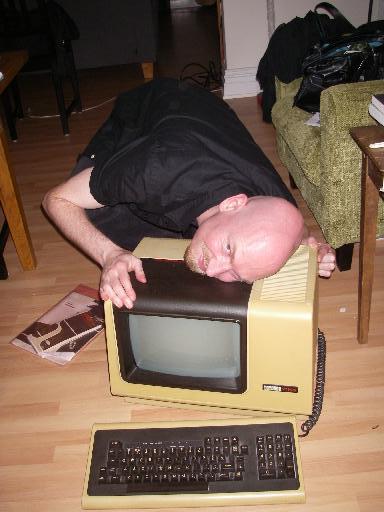
Internet connectivity to our home is sadly not Ethernet anymore. You can't win them all. We get nominally 200/10 Mbit/s downstream/upstream over cable TV from Tele 2, the part that used to be Comhem. For nearly a year they gave us native IPv6. Then just dropped it. Boooh! No response about why from their support. I had to rely on my connections in the ISP world to get to know what happened. Apparently they bought new hardware which didn't support IPv6 in a secure way so they just turned it off! Silently!
I manage with a Hurricane Electric v6 tunnel until they clean up their act.
The router is a PC-Engines APU2 with FreeBSD but the WLAN access point runs Linux.
My mobile phone operator, Tele 2, gives me native IPv6, which come in handy while travelling. Since Tele2 recently bought ComHem, perhaps I'll get my native v6 back in the flat as well?
In my vacation cottage I have symmetrical 100 Mbit/s over fibre. Yes, I know, fibre to the home in the cottage but not in the city. It's weird.
These days I mostly use the River Wayland compositor compiled without the Xwayland X server. The X Window System has finally been retired! Good riddance! It looks something like this:
I use River with the sandbar status bar and my own layout generator to get the much desired Monocle mode and as an experiment to add more stuff. I think stacktile is really neat, too, but I have some problems with it forgetting my environment.
swayidle and waylock locks the
screen on inactivity with
wlopm for power management.
On my laptops, kanshi automatically handles what to do when external monitors are attached and detached.
In the screenshot you mostly see two foot terminal emulators.. The one with the red border is running a local tmux with an Emacs client where I'm editing a gemlog entry. One terminal is running mosh to a remote machine where I'm editing this web page in Emacs in another tmux.
For a long time when I was using X11 I used a very simple tiling window manager called dwm with some extra patches. It looked something like this:
What you see are two frames from the same Emacs and an st terminal running tmux with a few shells. Looks a lot like the former screenshot, doesn't it?
Most of the time when I'm using just the internal screen on my laptop I used it in monocle mode which shows only one window at the time. Something like this:
It looks very similar with River under Wayland.
For a couple of years after abandoning X11 I used the Sway Wayland compositor looking something like this:
but I missed dwm and especially monocle mode so I was glad when River came along and matured enough.
My terminals are green on black. I'm trying to reproduce the colour of the P39 phosphor on some favourite old cathode terminals. P39 has a wavelength of 525 nanometres according to Wikipedia. The RGB value is something like #36ff00.
The font is the pixel font Terminus. No antialias, obviously. Click on it if it renders fuzzy.
For a few years I was using a window manager I wrote myself, mcwm. It might look spartan but I was quite satisifed until I realized I wanted a tiling window manager.
Here's a screenshot taken on 2012-04-26 from an HP thin client terminal running FreeBSD as a light workstation:
Click on the image above for the real screenshot.
You don't actually see much of my window manager per se: It never draws anything itself. It just asks the X server to give all clients a 1 pixel border. The currently focused window is marked by an amber border.
On the screen you can see a couple of urxvt terminal emulators. Some of them are running tmux on remote hosts. In the right top corner there's a clock (rclock) and a menu drawn by 9menu.
What you don't see are the rest of the virtual workspaces. I usually use about four or five.
There are, of course, no real icons. Ever. I really dislike graphic icons and having to shuffle windows around to find things. Considering this is how I felt I should probably have taken the plunge to tiling window managers earlier.
The fonts used are Bigelow & Holmes' bitmapped version of Lucida Typewriter in the 75 DPI flavour and the Terminus font.
You might want to compare the above screenshot with an MGR screenshot taken on one of my Sun workstations in the 1990s. Superficially, not much has changed. More about MGR and Suns at home below.
For many years I was using the CTWM as my window manager. You might find my .ctwmrc configuration file interesting. Key bindings and mouse actions on the title bar (if enabled) are provided for the most common window operations. I have made an attempt to explain what I do in the file.
Before that I was instead using its predecessor, TWM, in various configurations. I also got stuck for a period using 9wm in 1995–1996 when I was running Plan 9 at work and got used to the real 8½ window system. I was using wm2 in 1999–2001.
Of course, I have also tried and experimented with numerous other window managers, to name just a few I found interesting enough to configure a lot and/or patch: FVWM, AfterStep, WindowMaker, Blackbox, Openbox, evilwm, Ratpoison, and i3.
I also used a small utility called unclutter that hides the pointer
after some inactivity. I find it very useful to get rid of the mouse
pointer after a few seconds. I think I may have found it in the X11R5
contrib directory or perhaps on comp.sources.x. These days this is a
built-in functionality in River (riverctl hide-cursor when-typing enabled).
Like the old screenshot above tells you, I used to run and even occasionally hack on the Bellcore MGR Window System. I much preferred MGR over the bloated X Window System. Like everyone else I've given up long ago and used X for >25 years. Besides, X is now actually much faster than before, even on the same hardware. Now, with Wayland, I'm finally rid of the X horrors.
For a while, 2013–2016, I was tired of mucking about with configurations and tried living in the Appleverse, mostly using Macbooks for a while. It didn't work out in the long run, but you might be interested in my OS X survival guide.
The first computer I ever used, at least as far as I remember, was a Sinclair ZX80 or ZX81 belonging to my cousin Ove. This was probably in 1981 or 1982. I was nine years old. Ove explained some BASIC for me and showed me the source code to a Black Jack game. We modified it so I could do unlimited bets when playing. Mind blown! You could change the game!?
The ZX81 had a Zilog Z80 at 3.25 MHz and 1(!) kiB RAM. The storage media was an ordinary tape recorder, although I don't think I realized at the time where the programs were stored.
I think Ove had the 16 kiB memory expansion.
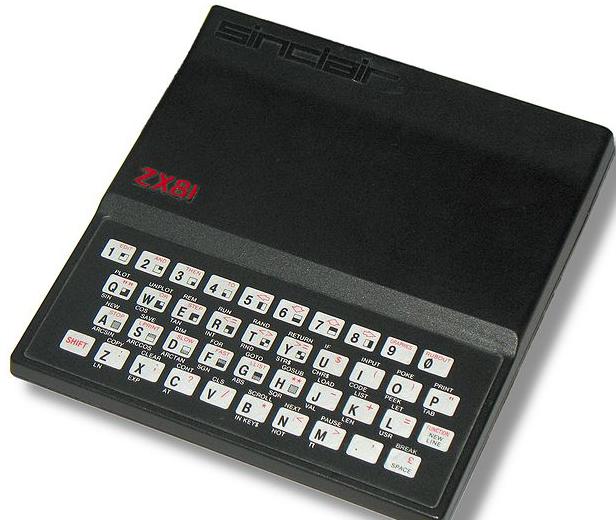
Photo in Public Domain, taken from Wikipedia.
It wasn't until a few years later, possibly in 1985, I finally got a computer of my own. I bought a Commodore Plus 4 for the price of a Commodore 1541 disk drive and got the disk drive as well. I believe the price was 2500 SEK. Owning a 1541 means I bypassed the rite of passage of handling a cassette tape recorder as a storage medium that plagued so many other home computer owners at the time.
The Plus 4 was a bargain, of course, but the reason was that the computer had fiascoed nearly everywhere. The reason was mainly that it wasn't compatible with the very popular Commodore 64. The Plus 4 was introduced in 1984 and almost immediately discontinued.
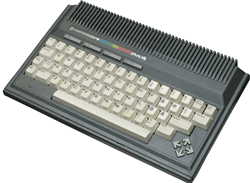
Photo by Anders Bengtsson from the PC/M Computer Museum.
Having a fiascoed computer with almost no available software meant I had to learn how to write my own software. The CPU was a MOS 7501/8501 (I'm not sure what was in mine, but they were both compatible with the 6502) at 1.77 MHz, with 64 kiB RAM with almost 60 k available RAM for the BASIC programmer. The C64 had a lot less.
The Plus 4 got its funny name because of a built in office suite
called Three + 1. The office suite was really horrible and not really
useful for anything. The word processor wasn't even useful as a text
editor! There was, however, a semi-useful machine code monitor in ROM
as well. You get at it with the MONITOR keyword.
If you for some strange reason want to experience the horrible Plus 4 first hand, the people at VICE have added the Plus 4 ROMs to their 8 bit emulator software.
I got rid of the Plus 4 after about six months and bought my first PC, a Commodore PC-10 PC clone in mint condition that had been used as a demonstration item. This was probably in 1985. I paid about 7000 SEK for it. It probably had 256 kB of RAM and two 360 kiB disk drives. The CPU was an Intel 8088 at 4.77 MHz. It ran MS-DOS 2.11. It had no graphics card, but displayed 80x25 of really crisp green text on a monochrome monitor. What a relief for my eyes compared to the Plus 4 that was hooked up to an old TV.
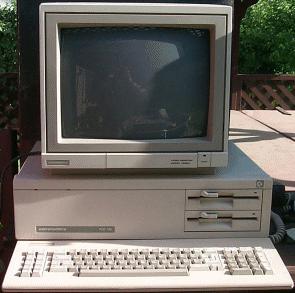
Photo from Bo Zimmerman's collection.
I leased a 300 bit/s modem from the state owned telephone monopoly Televerket (now TeliaSonera) and hooked it up to this PC, probably in 1986 or early 1987. The modem was about the size of a shoe box, weighed almost 4 kg and was worth about 3000 SEK at the time (almost 6000 SEK in 2011).
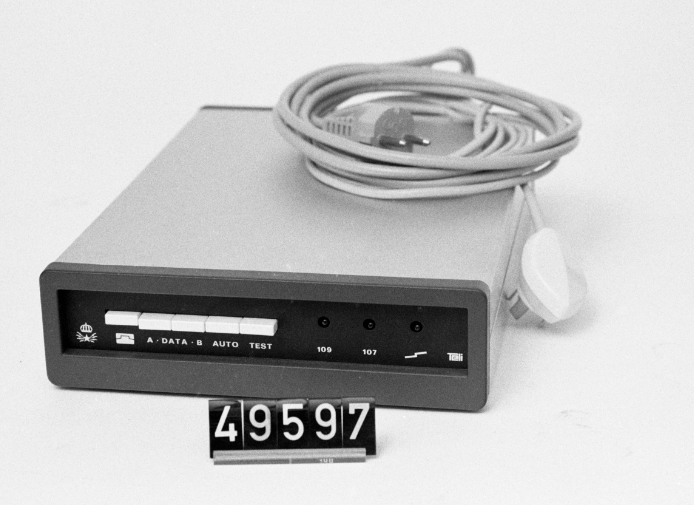
(Photo from Tekniska museet. CC-BY.)
I remember a frantic hunt around town to get a serial cable, but they were all so expensive I couldn't afford them. A cable would cost ~500 SEK, which when I'm writing this in 2011 would be almost 1000 SEK! A guy in what was really an office supply shop meant for businesses took pity on me and allowed me to lend a cable over the weekend and gave me a diskette with the Procomm terminal emulator.
The next week I went to the nearby (well, ~ 100 km) city of Sundsvall and bought a serial cable for 120 SEK (~230 SEK in 2011). Later I also bought one of the few programs I have ever paid for to that computer: Borland's wonderful Turbo Pascal compiler with its equally wonderful language reference manual.
Unfortunately, I was so hooked on using the modem and dialing bulletin boards, that I got a nasty surprise three months later when the phone bill came. It was over 4000 SEK (~7600 SEK in 2011)! My mother was rather upset and I helped her pay the bill with my saved money and still had to make a payment plan to pay it all back. Worse, I had to give back the modem! Instead, after a while, I loaned a 1200/75 bit/s modem from a friend and this time I was very careful about timing my calls.
300 bits/second was truly horrible. 1200/75 was a bit better but, of course, terrible for uploads. I didn't realize at first that it would have been cheaper just to buy a 1200 b/s modem.
I didn't know about offline readers or Fidonet points at the time. That might have saved me from this disaster. Strangely, I never used any offline readers during the Fidonet years.
I used the PC-10 for a couple of years and then bought my first Unix box, a used Luxor ABC 1600, for 5000 SEK in, I think, 1988. It ran a Unix version called ABCenix, sported 1 MiB of RAM and a hard disk with a total capacity of a whopping 12.5 MiB!
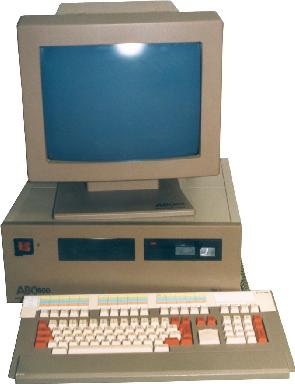
Photo by Anders Bengtsson from the PC/M Computer Museum.
The ABC1600 had a very nice monochrome twistable screen at a resolution of 1024x768. It even featured a window system, with every window being a graphical terminal emulator, much like MGR.

(Photo from my friend Linus Walleij who is rescuing an old 1600.)
The machine was pretty slow with a 68008 (note the "8") CPU and the 12.5 MiB hard disk was much too small. That, I guess, is the reason the ABC1600 fiascoed. The commercial fiasco was, of course, the reason I could afford to buy it in the first place.
Sadly, the 1600 had a hardware failure and I didn't know how to fix it. To my surprise, the guy I bought it from took it back and paid me back all my money!
I went looking for a new computer. I was considering a used Apple Macintosh Plus with an external 20 MiB hard disk. The total price, IIRC, was also 5,000 SEK.
I also considered a new Atari Mega ST with external hard disk for a total of ~14,000 SEK.
I finally went with a Commodore PC-40 PC/AT clone running MS-DOS. A considerable step backwards compared to the ABC1600, a multi-tasking multi-user computer with a window system!
The PC-40 had a 80286 CPU @ 10 MHz, 1 MiB RAM, 20 MiB disk, Hercules monochrome graphics and an amber monitor for a staggering 16,000 SEK (the equivalent of ~28,000 SEK(!) in 2011). I must have been mad! Both the Macintosh and the ST would have been much better choices. I can't even say that I fully exploited the 286. It mostly ran as a faster 8088. Had I gone with the Mac Plus I would have even have afforded a memory upgrade to a total of 3 megabytes for the same money!
Later, I also purchased a used PC clone, an Ericsson 9660, with 640 kiB RAM, two 360 kB disk drives and a black on white monitor. They both ran MS-DOS, of course.
By this time, I had also bought a 2400 bit/s modem to replace the terrible 1200/75 bit/s modem I had borrowed from a friend. I kept careful records of every phone call I made so I knew just how much of the phone bill I would have to pay to my mom.
There was still no local bulletin boards for a few years, except for my own experiments with friends, so I called long distance at about 2 SEK/minute during daytime and somewhat less during the night. It was cheapest between 22:00 and 06:00.
By this time the Swedish university network (SUNET) had terminal servers in different places around the country. The phone numbers had spread around the hacker community. SUNET back then was a very friendly space. Many computers had guest accounts, so you could experience Real Computers with real operating systems even if you had just a toy yourself. Unfortunately no terminal server numbers where in my area code.
I still didn't use any offline readers and was never a Fidonet point. I don't know why. Looking back, I find it really strange that I didn't use those alternatives.
My last year in Hudiksvall a local Fidonet-connected BBS opened by an enthusiastic teacher at the local secondary school. What a relief!
In 1991 I began my studies at Linköping University. I left the Ericsson PC and a modem with my mother at her request. She figured, correctly, that I would be hard to reach by phone, so we corresponded by e-mail, initially through a Fidonet-Internet gateway.
At the LiU I promptly became a member of the computer club, Lysator. Lysator had a rather special room at the university called PUL17. PUL17 was located underground, in a room next to a bomb shelter. The room mostly contained a very large air filter, containing lots of fine sand. PUL17 was mostly located on top of this filter, with raised computer floor tiles standing directly on the sand and chairs and desks on top of that.
I spent an incredible amount of time in there, to the point that my computer at home, now just the PC/AT mentioned above, was rarely touched. Instead, I spent my time mostly in front of one of many Facit 4431 terminals (originally introduced in 1983), lovingly known by us at Lysator as the "Green Menace" (Swedish: "Gröna faran"). The Facits were VT102 compatible and really, really nice.
For a while I borrowed a Green Menace to have at home in my dorm room and used it with a 2400 bit/s modem standing on top of it. I very much preferred the silent terminal with the great keyboard compared to using my noisy PC.
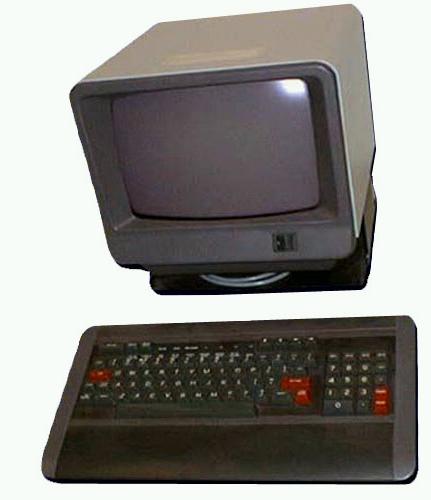
Photo from Informatik-Sammlung Erlangen.
The only thing wrong with the 4431 was that there wasn't more visible rows on the screen. It had 24 rows by 80 columns, like most character terminals at the time.
Here it is in on my desk next to a Tandberg terminal when I had moved in with my girlfriend the year after:

Lysator had a couple of Sun 3/50 and 3/60 workstations, but I mostly sat in front of a terminal, even though I would mostly be logged in to one of the Suns. At first, there were no Sun servers, so a lot of simultaneous users shared the Sun workstations.
The Suns ran SunOS, which was basically a BSD Unix, not to be confused with Solaris 2.x, which is a System V Unix.
There was also a Sequent Balance 8000 running Dynix available, but it was very slow compared to the Suns and was mostly used as a terminal server and to run the legendary MUD NannyMUD. Lysator later received plenty of equipment from Sun, Digital and others, but this was the situation in the early 1990s.
I also got access to some other computers over the Internet. One honorable mention is AIDA, a DECSYSTEM 2065 with TOPS-20 at Uppsala University. Here I am, many years later, clumsily trying to hug my old friend AIDA when it was a part of a museum exhibition:

Incidentally, this was the first time I saw the machine.
Unfortunately, LiU had scrapped their own DEC 20's the year before I enrolled. Lysator had one of LiU's old DEC 20's, but we didn't have it running.
In 1993 Lysator moved up from the cellars. Here's me in front of a terminal in Lysators new headquarters, Q:
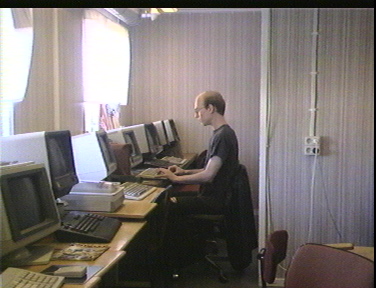
It looked pretty much the same in 1996, but with SPARCstations instead of character terminals:
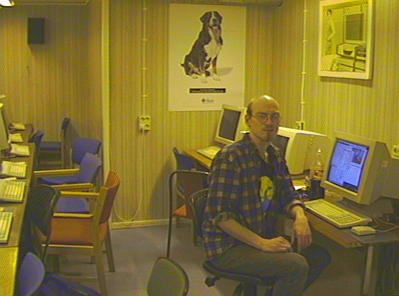
In 1992(?) I bought two used Sun 3/60 workstations. I paid 11,000 SEK for both. Their price as new in 1988 was at the time ~100,000 SEK each (about the double in 2012 SEKs). One of the Suns had a nice 19" monochrome monitor with a resolution of 1152x900. The Suns had 16 MiB and 4 MiB RAM, but no hard disks.
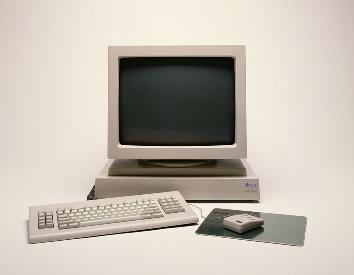
Photo from Juan Orlandini's blog but my guess is that it's taken from a Sun Microsystems brochure.
There wasn't enough room for any storage media in the pizza box style the Suns used for a case. Instead, I hooked a stripped PC box to a 210 MiB SCSI disk (which I bought for the incredible amount of 6,000 SEK and connected that to one of the Suns. I got some help to install SunOS on the thing. The other 3/60 was mostly left unused.
I mostly used the 3/60 sitting at a character terminal, so I could sit in another room and didn't have to hear the fan noise. It was a waste of the 19" monitor, of course, but this was the sane choice, believe me. The fan was terrible!
When I did sit at the console, I used the MGR window system (see below). Running X was not an option, at least not if you wanted to do something else on the same machine. Using a 3/60 as an X terminal might have worked OK, but I didn't have a server to connect to.
I still used the Sun with a 2400 bit/s modem. I used RMAIL in Emacs to read my mail. I had written a small Emacs Lisp function to append my outgoing mail to a file. I uploaded this file with Kermit and executed it on Lysator. The script then fed my mail through the sendmail program for further delivery. I downloaded my mailbox in a similar manner. It was a rather simple way of arranging offline mail and I used it for a long time.
In 1992 or 1993 I was given a Facit Twist terminal, also known as Facit 4440. The Twist in the name comes from the nice feature that you can twist the monitor 90 degrees from landscape to portrait. In portrait mode it has 72 lines! Very nice to hack on but no so nice to run under screen over 2400 b/s when I was connecting to remote systems over the modem. It took ages to redraw the screen when you flipped between terminals.
I believe the Facit Twist was introduced in 1986 priced something like 12,000 SEK (which would make it to close to 24,000 SEK in 2012).
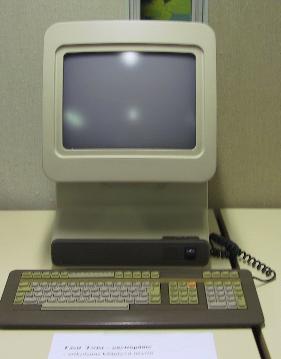
Photo from Lappeenranta University of Technology collection.
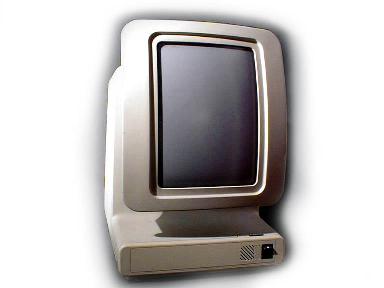
Photo from Informatik-Sammlung Erlangen.
This terminal was used a lot against the main 3/60.
Here's a blurry picture of it in my living room at the time:
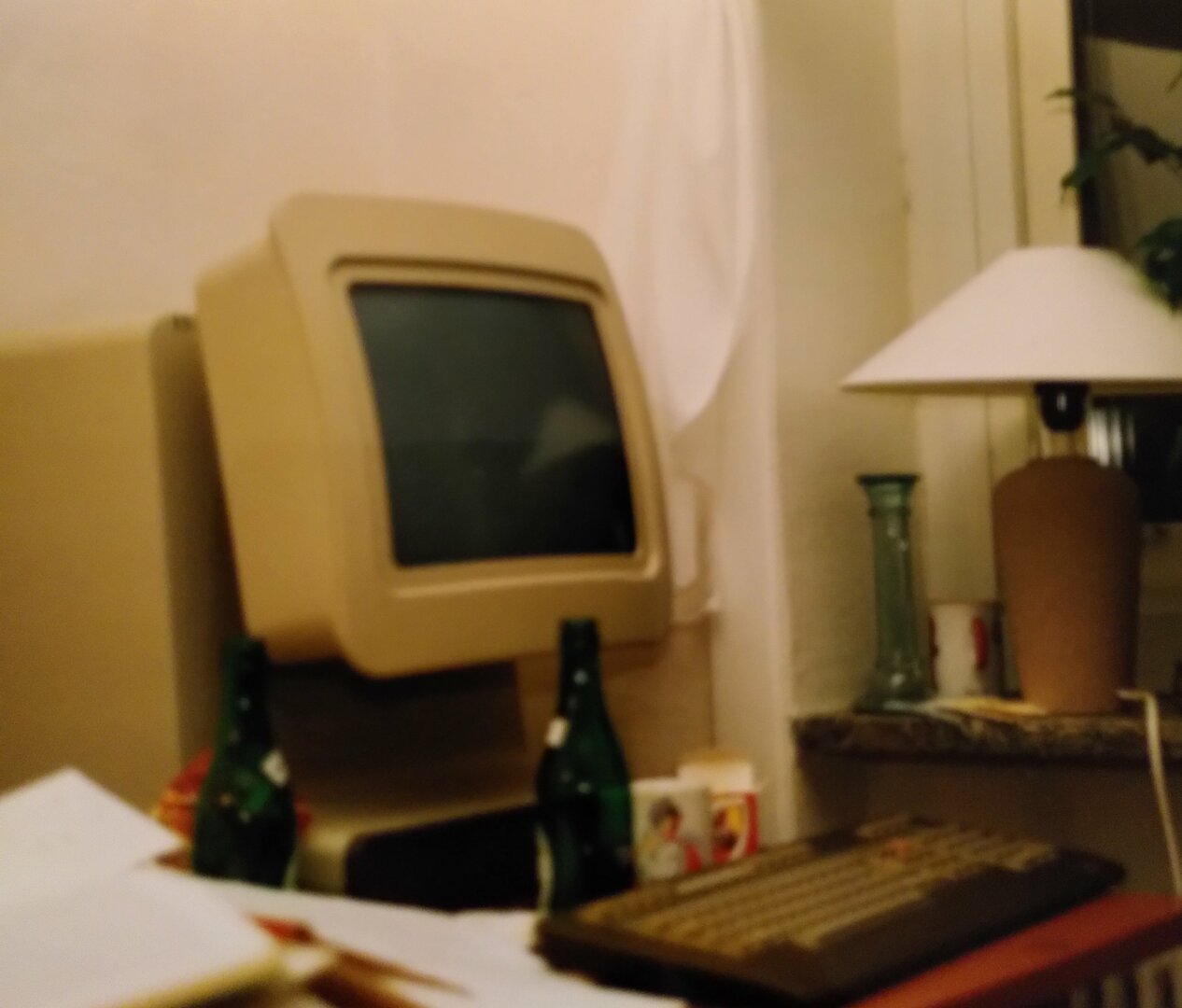
In 1995 I was working at Bull, in the part that was left of the Swedish computer company Diab, and rescued an old Diab DS90/20. It was a 68020 based mini running Diab's own Unix D-NIX. I think it had 8 MiB RAM. I had no less than two of the fancy Komkit-II Ethernet cards. Each of these also had a 68020(!) and the telnet daemon actually ran on the Ethernet card!
The Diab DS series were the big brothers of the Luxor ABC1600, which was also manufactured by Diab.
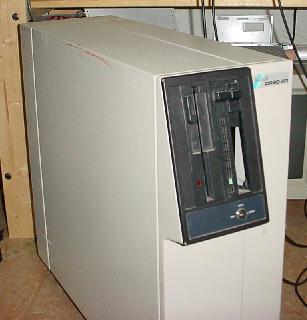
(Photo by Iggy Drougge from Linus Walleij's Diab pages.)
I think this photo was taken by my wife when I was configuring it at home:
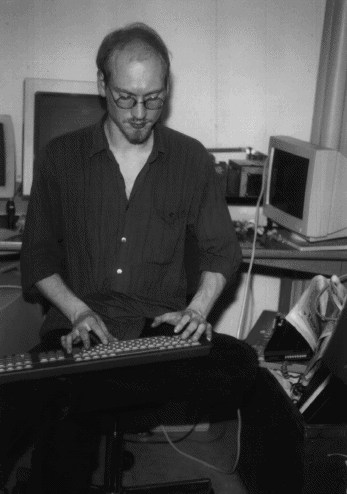
The keyboard in my lap belongs to a Facit Twist terminal temporarily standing on the floor. It's usual space was on the desk in my (silent) office in this flat. The terminal is here connected to the DS90 standing right next to it on the floor. Behind me you see the large monitor of a Sun 3/60 and to the right you can see the stripped PC box containing the Sun's hard disk standing on top of the other 3/60.
I named the DS90 closet, since it was running inside a walk-in closet where the photo above is taken. Again, I like to keep my workplaces quiet, so the terminals were usually in another room.
I ported many programs to D-NIX both at work and at home. Of course, I also had to port a lot of stuff to the terrible AIX that Bull for some reason decided to run on their DPX/20 servers and workstations (at first no more than IBM RS/6000 systems in disguise). One solace during my time at Bull in the middle 1990s was that I also got to know the Plan 9 operating system which was incredibly sane compared to the AIX madness.
One of the programs I ported to D-NIX was SklaffKOM, a bulletin board system in the tradition of the KOM conference system. I used it first on the 3/60 and later on the DS-90.
The DS90 closet, with SklaffKOM, served as a dial-up public access Unix system in the +46-13 area code, taking over after one of my 3/60s. The actual BBS, which was the only thing you could get at if you didn't talk to me and got a real Unix account, was called Hackmaskinens KOM (The Hack Machine BBS) at first, but was later known as IBKOM.
I had a dial-up UUCP connection for mail through the DS90. The system
was reachable through Lysator as
lysator.liu.se!closet or user%closet@lysator.liu.se. I had two
phone lines, but one was mostly for voice and the occasional modem
dial-out by me. The other line was connected to closet with a 9600
bit/s modem that was used both for people dialling in and for the UUCP
transfers every 15 minutes.
Later in 1995(?), I sold both my 3/60s and bought a used Sun SPARCstation ELC for 8000 SEK. I almost bought a used NeXTstation for about the same money, but the ELC won.
The ELC was a cheap diskless SPARC based workstation with 16 MiB RAM built into a monochrome 17" 1152x900 monitor. Here it is on a desk in my living room a few years later, probably 1998:
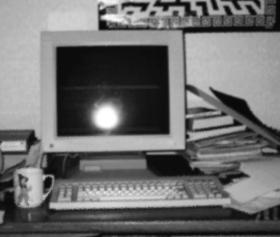
It was meant to be used as a diskless workstation, but since I didn't even knew how I would do that from the DS90 I used a shoebox-sized external SCSI disk. I think it was 200 megabyte. Unfortunately, the box containing the disk had a loud fan. Other than that, the ELC was dead quiet.
The ELC began life running SunOS (not Solaris), but after a few years I installed Linux/SPARC. I think it was a Red Hat distribution, since the company I worked for sold Red Hat distributions at the time.
I initially used the MGR window system on the ELC, just like on the 3/60. I gave up on MGR on the ELC in 1997 and started using X and the graphical Linux console pionereed by the SPARC port. I think I switched to X when I ditched SunOS and installed Linux/SPARC.
By that time, I also had an NCD X terminal at home, so two people could run graphical programs on the ELC at the same time. Here's a photo of the NCD 16, a fanless monochrome X terminal based on a 68000 CPU with the a resolution of 1024x1024. Yes, the monitor was square.

This great terminal also had support for the Xremote protocol, which I think is what later turned into Low-Bandwidth X (LBX). This made it really useful even over a 9600 bit/s modem connection, unlike most other X terminals.
Here's a screenshot from the terminal running twm:
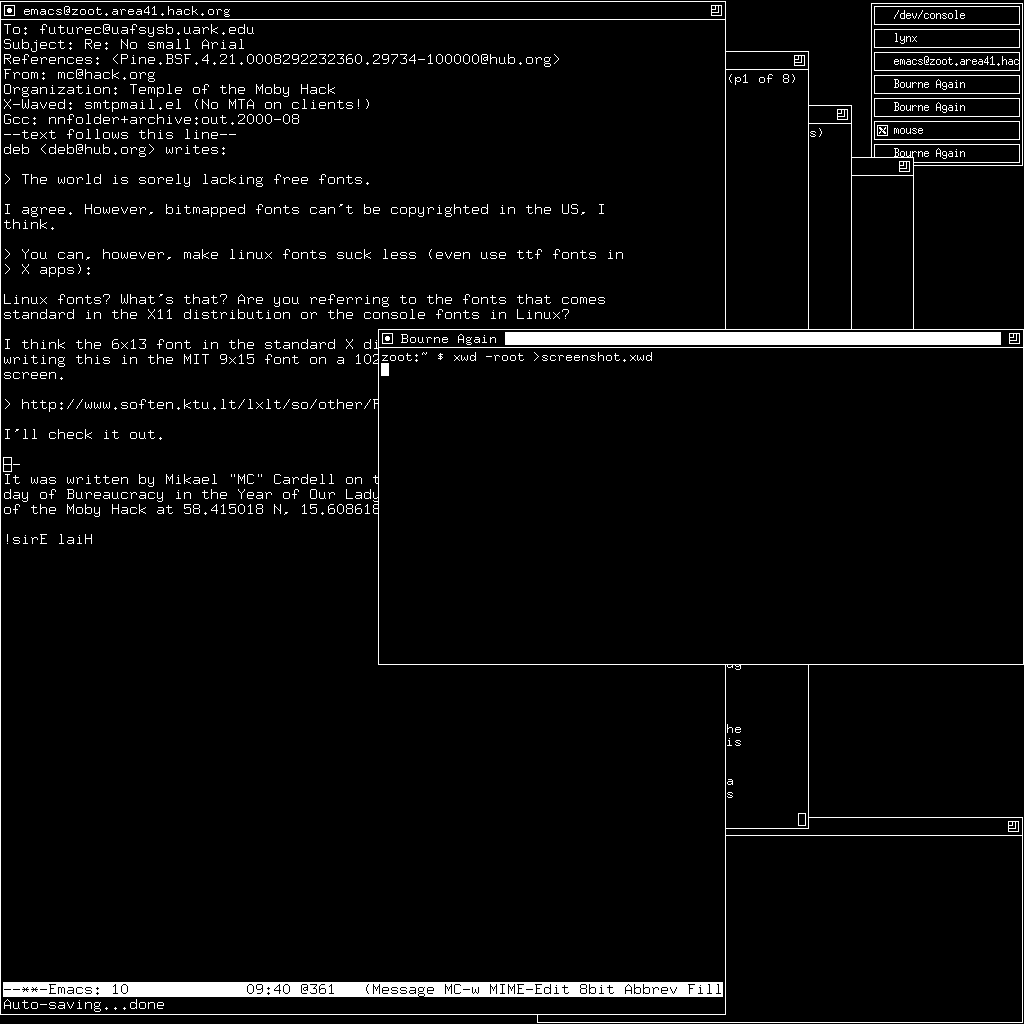
By that time, 1995–1996, the DS90, the ELC and the X terminal were connected with a thin coax Ethernet. Several character terminals were also hanging off from closet and available for local users in my flat.
At work at the time, I hooked up a Visual 102 terminal to the Alpha workstation on my desk. When I found myself needing to concentrate on a task I often moved over to my retro desk. It looked like this:
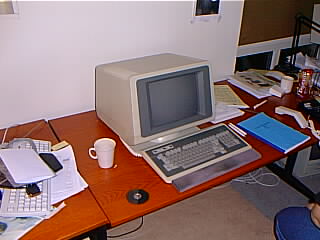
In 1996 I placed the NCD terminal at a friend's collective which was close to our flat. They had arranged a connection to the Internet with Vitalink Ethernet bridges connected over a leased line! This was really rare at the time for a private home in Sweden. Suddenly, I didn't have to go to work or to Lysator or use an expensive dial-up connection. Sweden had, and still has, metered local calls, but they're much cheaper now than they were at the time.
Here's a picture of Magnus and me in our 'office' in front of our X terminals. I think Magnus' terminal might have been a Digital VXT 2000.

The photo was taken by the third adult occupant, Christer Weinigel.
In 1997, my wife and I separated, and me and Ludvig moved to a room in this collective for a while. My move was also the end of the public access Unix systems and the BBS. Sadly, I don't recall what happened to the DS90-20 and the BBS. This time of my life was rather chaotic.
I later moved back in with my ex wife and in the summer of 1998 we formed the Area 41 collective together with some friends. The public access Unix and the UUCP feed was gone, however.
The Area 41 collective eventually had four adults, two kids, something like 15 to 20 computers and redundant Internet connections (one over cable TV, one over ISDN).
My next main home computer was an old Sun SPARCstation 5 with a 19" colour CRT with 1152x900 pixels that I rescued from work at SICS in 1999. I named it caerbannogh, after the "Rabbit at Caerbannogh", the one with big, pointy teeth.
This was possibly my second colour computer at home if I consider the Plus 4 hooked up to a colour TV my first. Monochrome monitors were simply so much better at the time that the colour alternative wasn't very interesting.
The SS-5 initially ran Linux, but was later running OpenBSD as a server. It was lated placed in co-location and turned into the main hack.org server.
From late in 1999 to early 2005 my main computer was an IBM Thinkpad 570 laptop initially called dingo, then fuckup. It looked like this one:
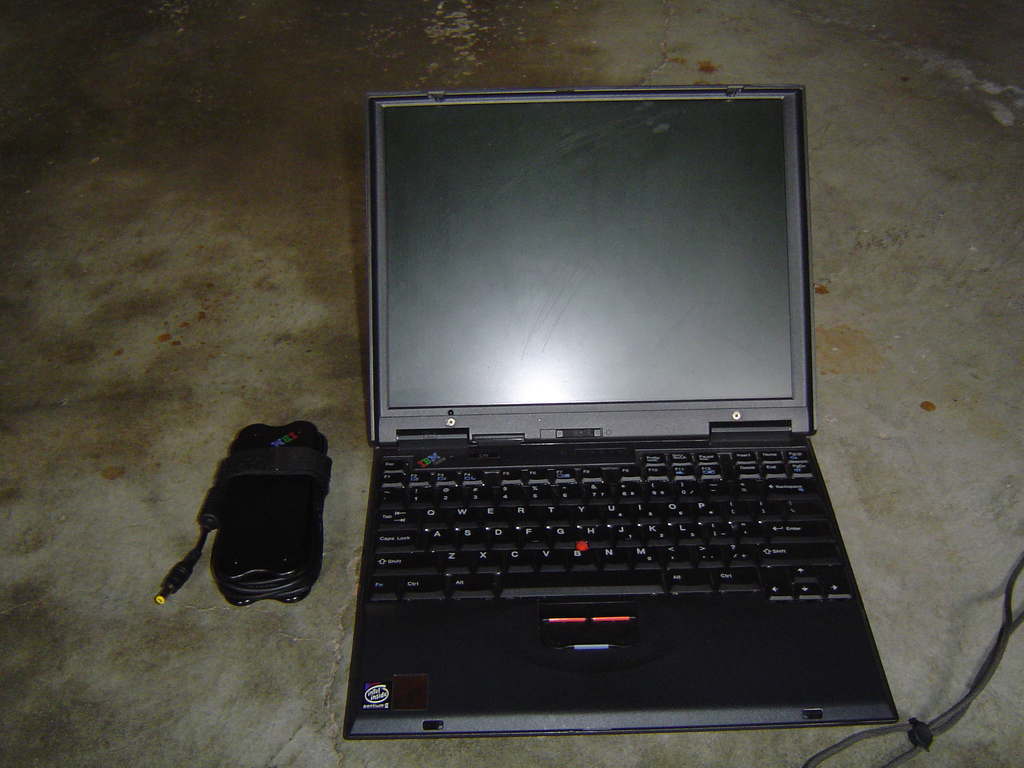
(Photo by Joe Lipson, CC-BY-ND.)
This was my very first laptop. I think it had a Pentium II and 64 MiB RAM. Not sure about the HDD, perhaps 4 GiB? Note that it doesn't have Ethernet nor any wireless network! I used a PCMCIA Ethernet card with it most of its lifetime and just at the end managed to get hold of a couple of Symbol 2 Megabit/s wireless cards which we ran on an ad-hoc network in the flat.
In any event the Thinkpad was both smaller and had more power than any computer I had ever had before. In fact, I'm sure it was more powerful than most (all?) of my previous computers combined. I used it almost daily for six or seven years, initially running Debian, then OpenBSD, then FreeBSD.
At first I used it in the Linux console, refusing to use the bloated X11. I used the console with the SVGATextMode hack to get more text on the screen. There was no framebuffer console back then on x86 Linux.
It continued life until 2009 Gabriel's computer.
The Thinkpad 570 is the immediate predecessor of the Thinkpad X series. I completely fell in love with these light, but powerful machines and used a series of them for a long time. I was sceptical about laptops for a long time, but the Thinkpads really showed me what freedom a laptop can give.
In 2000 or 2001 I bought a used Digital Alpha XL266 for use as a server. This was the same XL266 I had previously used under my desk at work from 1996 to 1999. It was turned into the main hack.org machine from 2001 to 2002, I believe. I ran Linux on it.
When it broke down in 2002 and I failed to repair it I initially used my Thinkpad 570 as an emergency server standing on my kitchen table. I found a replacement by building a PC from old, very standard parts. This was zoot, which was the hack.org main server from 2002 to 2005. It ran FreeBSD.
In 2002, I also purchased a used Sun Ultra 1 with 192 meg RAM, 4 gig disk and a very heavy 19" CRT (~ 35 kg) for less than 1000 SEK and installed Linux on it. It was used a lot as a second workplace, mostly by my wife. It ran in a noise-cancelling box, fortunately. The Ultra went to a better home in 2012.
I have donated almost all my other old computers to other collectors. Hopefully, my collection has gone to better homes.
In 2005 I bought a Mini-ITX card with a VIA Eden CPU and a small case. It was intended as a small workstation but was instead quickly made into the home server running FreeBSD in a closet. The Mini-ITX served as well a home server and later got a second life as a router but is long since retired.
Instead of using the Mini-ITX as a workstation as I originally intended I bought a Hewlett-Packard t5125 thin client to use as an X terminal. I used it a lot for about a year. Here it is:
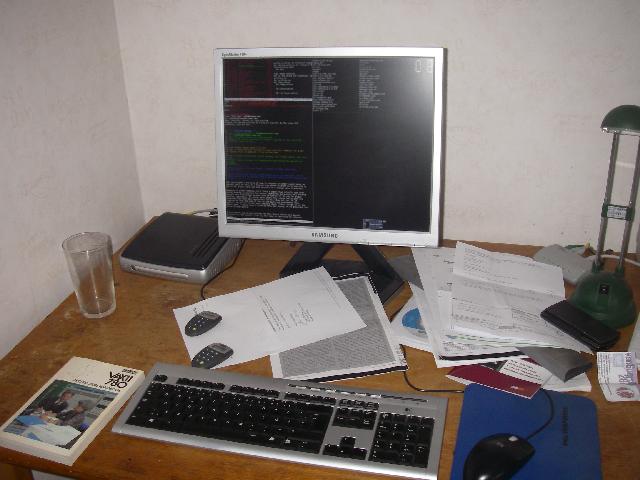
The terminal is the small box at the top left, close to the wall. Note the VAX 11/780 manual!
In 2006 I bought an IBM Thinkpad X60s laptop to use as my main workstation. My wife began using the t5125 terminal instead so we could retire the noisy Sun Ultra 1.
Here's the X60 on my office desk when it was quite new. It has a wifi PC Card since the built-in wifi didn't yet work under FreeBSD.

I often used it wired anyway, especially since I got these nice braided cables from a friend:
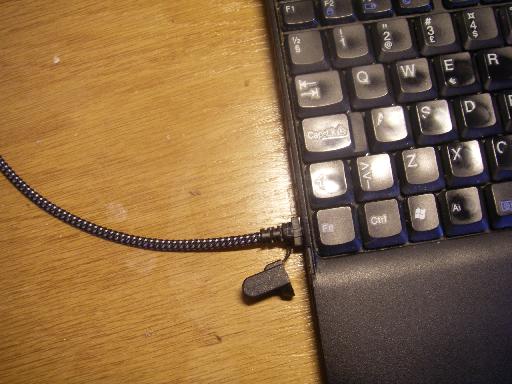
You can see from the fading letters on the keys that this photo was taken quite some time after the first.
I have written a text about doing a network install and running FreeBSD on the Thinkpad X60s that might still be of interest to some of you. An earlier version also covers how to do a network install of NetBSD and Ubuntu Linux on the machine.
The X60s later ran Plan 9 for a while, then I gave it to my youngest with Ubuntu installed. They used it mainly for Tux Paint and some games before they got completely stuck in an iPad in early 2015. In late August 2015 I installed Manjaro Linux on it and gave it to my Gabriel who was moving out to attend university and needed a laptop on short notice.
Here's the Thinkpad X60s and the HP t5125 terminal, probably in 2006. The terminal's monitor is on top of an old Cisco 4000 router I had lying around:
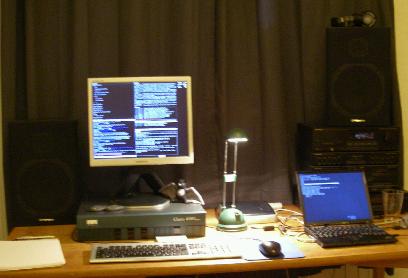
Here's a photo of my setup at home as of July, 2011:
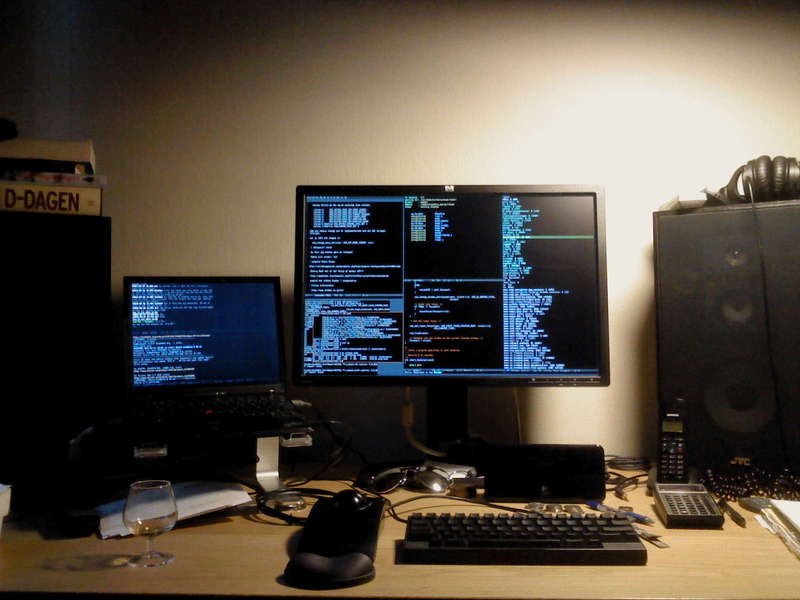
On the picture you see the Thinkpad X60s on top of a small stand, an external monitor, a Hewlett-Packard ZR24w 24" IPS panel at 1920x1200, an external Happy Hacking Keyboard Professional 2, a CST L-Trac X trackball, two huge JVC speakers with a pair of Sennheiser headphones on top, an old TI Programmer calculator, a Siemens DECT phone and a wonderful Squeezebox Classic music player.
The speakers on the photo are connected to a huge Sony STR-DG520 receiver under the table which in turn is connected to the Squeezebox Classic.
In 2011 my friend Linus gave me a Genesi Efika MX Smartbook. I used it mostly on travels and as a kitchen computer and thought about retiring the Thinkpad.
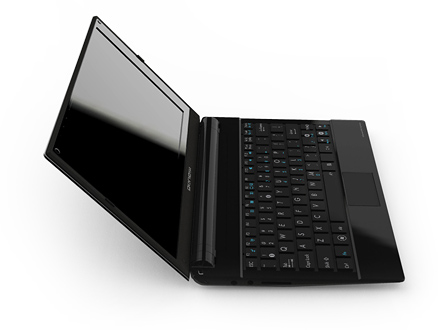
In 2012 I bought the Supermicro Superworkstation, totoro mentioned above, and tried to use it as a workstation. That didn't work, of course, because of the hellish fan noise, so I hooked up the old t5125 terminal and used it like that for a while.
Continuing the thin client trend I bought two Hewlett-Packard t5745 and used them with totoro, replacing the aging t5125. I had one terminal in an upstairs office and one downstairs in the living room.
Here's what my upstairs office looked like in 2012:
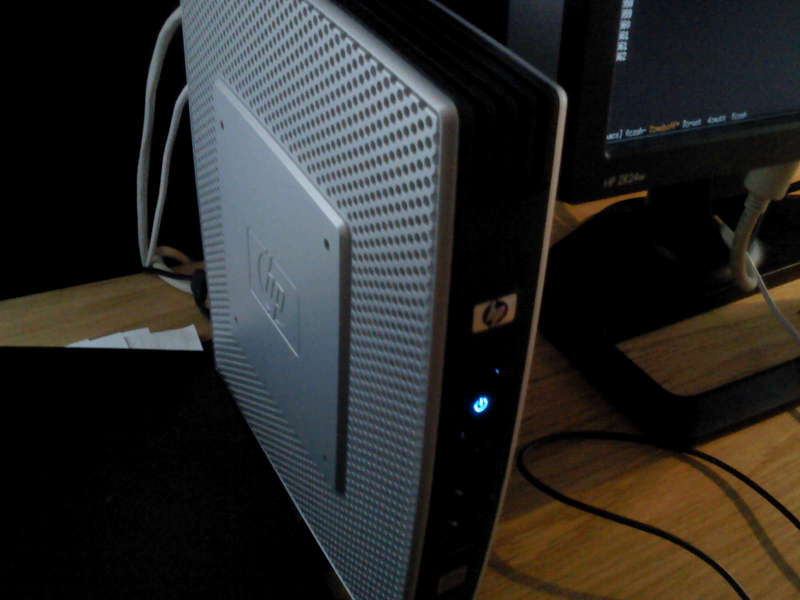
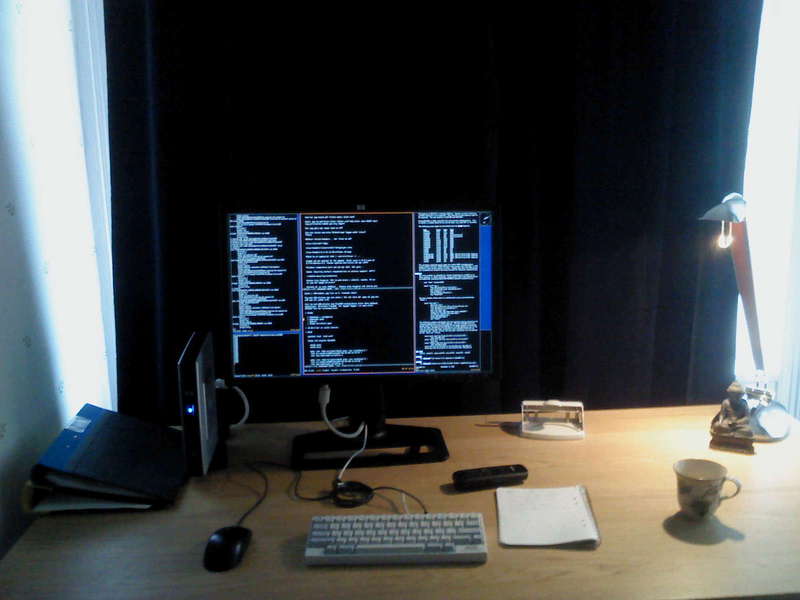
Aah! The silence!
I didn't use them as thin clients. Instead I ran FreeBSD on them and used them as light workstations but running the heavier stuff on totoro.
These terminals have an Intel Atom N280 x86 CPU and 1 GiB RAM (expandable to 8!) so using them as ordinary workstations is quite easy.
They ran a lightweight version of FreeBSD booted from USB memory sticks. A few programs ran locally (window manager, a clock, terminal emulators, ssh, et cetera) but most real work was done on totoro.
This was my setup until mid-2013 when I finally decided I needed a more powerful laptop again and bought a Macbook Air.
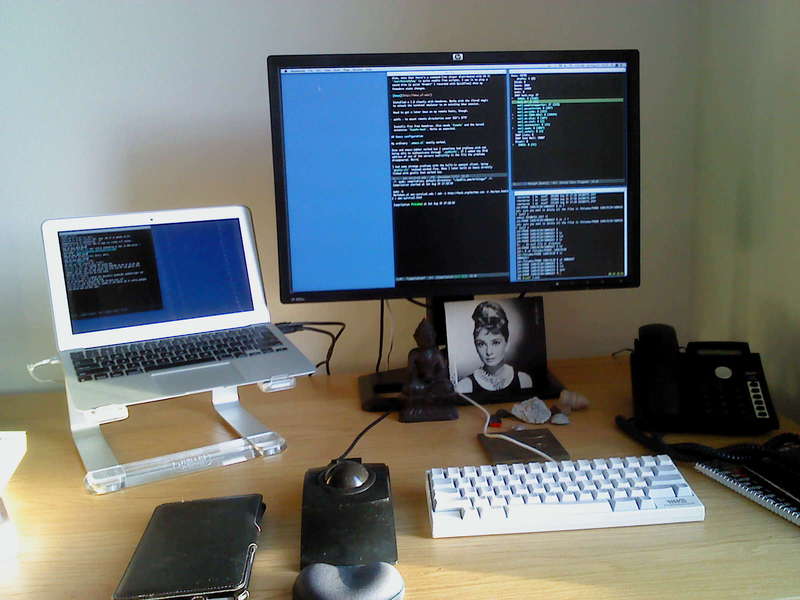
It's a mid-2013 Macbook Air 11" with i5 (Haswell) @ 1.3 GHz, 8 gig RAM, and 128 gig SSD. It's small, light (~ 1 kg), very quiet (really important!) and has just about the oomph I needed, although storage was a little cramped.
It has an American keyboard. A friend who saw it said "Oh, it has one of those programmer's keyboards!". As you can imagine, ANSI style keyboards are pretty rare in Sweden.
I have written a text about using OS X called OS X survival guide that you might want to read. I find OS X pretty much a real Unix. I feel mostly at home after many years of *BSDs and Linux. Most of it is just plumbing for Emacs, anyway, but with working hardware... Ah! Suspend/resume!
Of course, I experimented with running FreeBSD on the thing, but the Broadcom wifi obviously didn't work and suspend/resume was so-so. I tried a few Linux distributions as well and they had better hardware support, so much so that I switched to Linux on the Macbook Pro I used at work at the time.
When I moved on from macOS I kept the Macbook around as a media computer and for ripping CDs. When it stopped getting updates I installed Ubuntu on it and gave it to #3.
For a while from 2016 I also experimented with using Chrome OS on a fanless Toshiba Chromebook 2 (CB30-B-104). I'm quite surprised how useful a stock Chromebook is as a mosh and SSH terminal and would probably be able to real work from one of these if the servers were set up accordingly. Although I admit it's much nicer when I can control what window manager it's running.
I then installed a native GNU/Linux on it and used it more as a real computer before giving it to #3. #3 later replaced it with the Macbook.
From February 2009 to spring 2022 I used a Fujitsu-Siemens Econel 100 with an Intel Core 2 CPU, 4 GiB of ECC RAM running FreeBSD as my home file server. I changed spinners a few times and at the end it was running with 3 TiB mirrored on ZFS. At first I also used it with the HP t5125 above until I bought totoro in 2012.
I've been into retro-computing for quite some time, even though I'm less active now than I used to be. I have experienced first hand such operating systems as ITS, RSX-11MPLUS, RT-11, TOPS-20, Unix Edition 7, PRIMOS and many others.
I still keep several user accounts on large, ancient machines such as PDP-10s and PDP-11s that are, believe it or not, still available on the networks, although in some cases they are run as emulators.
A few years ago, I got rid of most the ancient hardware I had collected. SWMBO was not very impressed with all the junk in the flat at the time. Anyway, I guess I'd rather have something really useful around than museum items, so I gave them away to (hopefully) better homes. I do, however, keep a lot of emulators around. I enjoy reading old source code.
I still really enjoy reading and collecting technical manuals, especially really old manuals, just because they are there. It's like climbing mountains, really; you just have to know what it looks like on the top.
In my modest collection I have a set of 'handbooks' from DEC for the PDP-11 and the VAX, some of the manuals for the TOPS-20 operating system and the ITS 1.5 Reference Manual. I was actually the one who got the friendly people at the MIT AI Lab library to scan it in the first place. I also have the only thing worth reading about the PC: The IBM PC Technical Reference.
I also keep the complete source code for many commonly used system programs and complete source code for some ancient operating systems, including ITS, TOPS-20, Multics and others. I find pleasure in collecting and reading source listings like these. These things are true wArEz, kids! I'm k00l now, right? Right?
Last updated: <2025-04-01 00:29:28 CEST>